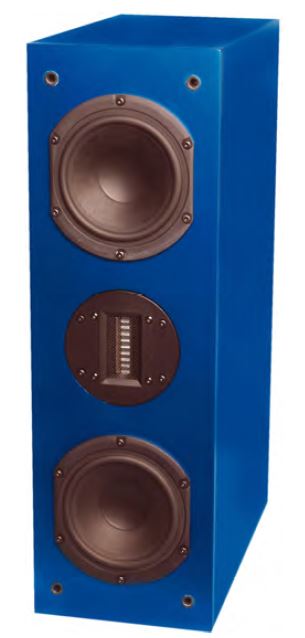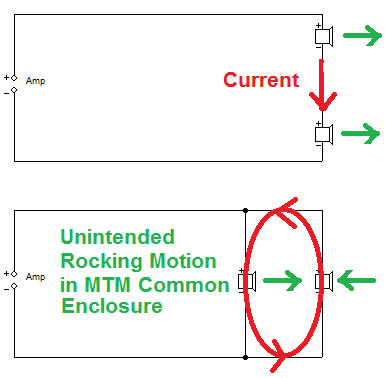Has anybody expirience with the 2 4 ohms midbass in Series, -and then in parallel with the High tone driver. I have bought scanspeak 18w4531G00 and R2904/700005 drivers too a very good Price and was told that this should not a problem soundwise but cant find Any exambles with this setup, or anybody with expirience in this setup?. I know It Will be 3 dB lover, that is not my problem. Thank in advance.
If I'm interpreting your question correctly, this is exactly what's in Curt Campbell's "Tritrix" MTM speakers: two 4 ohm Dayton DC130BS-4 mids connected in series, the tweeter is a Dayton DC28F.
Different drivers of course, but the principle's the same.
Tritrix_pg_3
Many, many pairs of these have been built including ours; excellent speakers for the $$.
Geoff
Different drivers of course, but the principle's the same.
Tritrix_pg_3
Many, many pairs of these have been built including ours; excellent speakers for the $$.
Geoff
There is a design at Madisound for your 18w4531G00 woofer:
18W4531G + D3004-6620 Passive Crossover Design - Madisound Speaker PDF Library
To convert that to series MTM, you double the bass coil to 2.2 mH and halve the bass capacitor to 10uF. The resistor becomes 2R. It's the same loudness on axis as a single bass driver.
I would think the tweeter circuit will work with almost any scan tweeter. Usually just adjust for level. Probably about 30-40L common enclosure with reflex.
18W4531G + D3004-6620 Passive Crossover Design - Madisound Speaker PDF Library
To convert that to series MTM, you double the bass coil to 2.2 mH and halve the bass capacitor to 10uF. The resistor becomes 2R. It's the same loudness on axis as a single bass driver.
I would think the tweeter circuit will work with almost any scan tweeter. Usually just adjust for level. Probably about 30-40L common enclosure with reflex.
Last edited:
Thanks system7. I was not sure if I loose som details/musicality (deep bass, mid tone details, Sound specter etc…) compared to drivers in parallel (2 x 8ohm drivers) but what I read from your answer this is not the case. - I only loose around 3 dB. Is that correct?????
No, you don't lose 3dB. You've halved the current draw, but doubled Sd so SPL remains unchanged relative to a single unit -you just have significantly higher power handling.
Where you may (may) need to be careful is in pair-matching. Since you've Scan drivers that's unlikely to be an issue, since their QC / QA tolerances are generally excellent. However, when there is a significant shift in electromechanical characteristics between the drivers, and they are sharing the same volume, that can start to introduce some undesirable interactions (especially if vented). As noted though, unlikely to be an issue with Scan-built units, it's just a general point worth keeping in mind for series-wired units in the same box.
Where you may (may) need to be careful is in pair-matching. Since you've Scan drivers that's unlikely to be an issue, since their QC / QA tolerances are generally excellent. However, when there is a significant shift in electromechanical characteristics between the drivers, and they are sharing the same volume, that can start to introduce some undesirable interactions (especially if vented). As noted though, unlikely to be an issue with Scan-built units, it's just a general point worth keeping in mind for series-wired units in the same box.
Phhbuilder
Would be great if you could share a small build log if you proceed with these. I have some Dayton DC160's & DC28F's to build a couple of series crossed MTM's also. More along the Tritrix build for me. HTGuide.com in the completed speaker designs section has information on many MTM designs. Have fun.
MM
Would be great if you could share a small build log if you proceed with these. I have some Dayton DC160's & DC28F's to build a couple of series crossed MTM's also. More along the Tritrix build for me. HTGuide.com in the completed speaker designs section has information on many MTM designs. Have fun.
MM
Scottermoose. Thanks for input. Could it be an advantage to use 2 vented ports, one ending near the upper driver and the other near the lover driver (ofcourse split the calculated port area in 2), even so they are in same “room”? For info i plan too have the vented port out in the bottom of the speaker
Kokanee. For sure i Will. The Project Will take some time for me, I know that. But I May Update this thread from time to time, or Throw new questions…..
Not particularly, unless you only have access to those of course. For a given total CSA, two vents will always have higher frictional etc. losses than one, so assuming you don't want that as part of the alignment, I'd stick to a single vent, check what eigenmodes (if any) are present in the cabinet, and ensure the vent is located appropriately to either exploit that, or help minimise unwanted harmonic modes from the fundamental. You can damp the latter out of course, but all other things being equal, efficient design is one that 'does the most with the least'. 😉
I have never given any thought to "Eigenmodes" in loudspeakers... though I am sure you know what you mean...
Is this quantum mechanics? 😀
A most excellent way to build an MTM is this, IMO:

Very good cylindrical dispersion which is the heart of the MTM sound, which projects well and reduces power to the room, so less effects from a lively room acoustic. I would keep the reflex port symmetrical to the two bass drivers. Must help.
Let's say the Jury is out on common enclosures with series MTM.
My notion is series is better than parallel in a common enclosure. Impedance is better too:

Looks a fun project. Good drivers, those Scans. Simple crossover too. I have heard them in MTM.
Is this quantum mechanics? 😀
A most excellent way to build an MTM is this, IMO:
Very good cylindrical dispersion which is the heart of the MTM sound, which projects well and reduces power to the room, so less effects from a lively room acoustic. I would keep the reflex port symmetrical to the two bass drivers. Must help.
Let's say the Jury is out on common enclosures with series MTM.
My notion is series is better than parallel in a common enclosure. Impedance is better too:
Looks a fun project. Good drivers, those Scans. Simple crossover too. I have heard them in MTM.
What you mean by "Unintended rocking motion", can you explain little more?
Is it about current or mechanical motion?
Is it about current or mechanical motion?
It's the overall mechanical motion that has us scratching our heads. Just that I gave some thought to the electrical effects too, especially with some stray resistance playing a part.

I wouldn't lose too much sleep over it. That's my theory, especially in a closed box, where pushing one speaker in doubtless pushes the other out, you follow?
Coupled Pendulums - Sixty Symbols - YouTube
It's the old "Coupled Pendulum" notion. Each driver might take turns moving and being stationary. You'd need a flashing light stroboscope and a driving frequency to properly investigate it! Has anyone ever done this? No idea! 🙂
I wouldn't lose too much sleep over it. That's my theory, especially in a closed box, where pushing one speaker in doubtless pushes the other out, you follow?
Coupled Pendulums - Sixty Symbols - YouTube
It's the old "Coupled Pendulum" notion. Each driver might take turns moving and being stationary. You'd need a flashing light stroboscope and a driving frequency to properly investigate it! Has anyone ever done this? No idea! 🙂
I would say such problems are more likely in series connected drivers than parallel connected ones. The Re of the drivers will reduce that circulating current by great measures, especially if one considers that the voltages induced in the voice coils are shorted by the driving amp.
Regards
Charles
Regards
Charles
“That's my theory, especially in a closed box, where pushing one speaker in doubtless pushes the other out, you follow?”
All else the same between the two drivers in mtm configuration (open to the same box space) the drivers would not act seperately (one in/one out) but act in unison effectively limiting overshoot in each other making for a tighter mid/bass?
All else the same between the two drivers in mtm configuration (open to the same box space) the drivers would not act seperately (one in/one out) but act in unison effectively limiting overshoot in each other making for a tighter mid/bass?
If speakers are installed symmetrically in the box and all wires are also symmetrical, there must not exist this kind of problems.I wouldn't lose too much sleep over it. That's my theory, especially in a closed box, where pushing one speaker in doubtless pushes the other out, you follow?
I have never given any thought to "Eigenmodes" in loudspeakers... though I am sure you know what you mean...
Is this quantum mechanics? 😀
Aka ‘standing waves’, in this case referring to the longitudinal mode & it’s related harmonics, which can alter the alignment compared to a pure Helmholz (cavity resonance).
Let's say the Jury is out on common enclosures with series MTM.
My notion is series is better than parallel in a common enclosure. Impedance is better too:
It’s higher, certainly, though the price is sensitivity so on that front YMMV. Assuming perfect drivers ie mathematically fixed behaviour then there isn’t much difference in performance beyond these macro factors but with dissimilarities introduced interactions/ resonances can crop up -Lynn mentioned some of these elsewhere, and that can be a consideration when they are sharing the same acoustic volume. In practice both usually work fine with quality drivers so depends what you have / want. I ran series with a couple of SB based mtm designs for e.g. since the 4ohm drivers I measured were rather better pair matches (& closer to published spec.) than the 8ohm equivalents, making it the more sensible solution in that situation. Worked fine, though ‘high sensitivity’ they were not. 😉
You're bringing up the right points, perhaps not in the right order. If the drivers are doing the same thing then they'll stay in their own half of the box.All else the same between the two drivers in mtm configuration (open to the same box space) the drivers would not act seperately (one in/one out) but act in unison effectively limiting overshoot in each other making for a tighter mid/bass?
Ahh got it, the pressures just meet in the middle….. although (given a closed box) that only makes sense to me on positive pressure (speaker cone moving inwards) on the negative (cone moving outwards) wouldn’t that have to effect the other driver as in fighting each other and tightening things up a little?
Eloquently put! 😀
So is there any benefit/detriment to separating the two with a partition?
Or does this balance of pressure help keep things coplanar?
So is there any benefit/detriment to separating the two with a partition?
Or does this balance of pressure help keep things coplanar?
Last edited:
- Home
- Loudspeakers
- Multi-Way
- MTM Speaker drivers